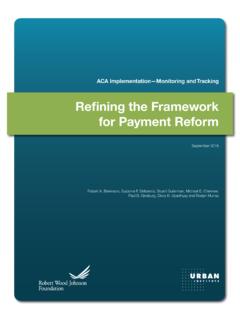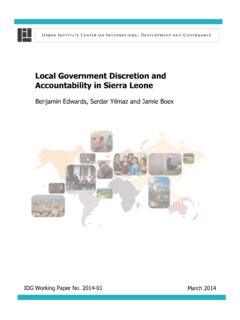Transcription of PPreventingreventing VVandalismandalism - Urban Institute
1 This guide is one in a series of crime prevention publications designed to equip current and potential Safe City partners with low-cost tools to assess their crime problems and to develop strategies to address them. Other guides in this series include panhandling, car crimes, public disorder, retail burglary, and Safe CitySafe CitySafe City is a model community-based initiative that aims to reduce crime, build awareness, and develop communities into safer places to live, work, and shop. Community partners in cities across the modify the model to best suit their needs and resources. The goal is to leverage existing resources by building collaborative relationships between law enforcement, businesses, residents, government leaders, property managers, and community organizations. This approach maximizes the tactical, fi nancial, technological, and human resources available to address a community s crime problems.
2 The Safe City model promotes partnerships and technical solutions as instrumental building blocks for success. These partnerships are further strengthened by individual retailers taking ownership over the crime and disorder problems occurring in and around their City has partnered with the Urban Institute , a non-profi t policy research fi rm, to develop a variety of crime prevention strategies for use in retail settings, many of which are inexpensive and easy to implement. For more information about the Safe City program, please visit For more information about the Urban Institute s justice policy research activities, please VandalismUnderstanding VandalismDefi nitions of vandalism vary by jurisdiction. In general, vandalism is willful or malicious damage to property, such as equipment or buildings. Vandalism is often associated with other signs of social disorder, such as disturbing the peace and trespassing.
3 See the Safe City guide Preventing Public Disorder for more information. Furthermore, vandalism incidents are burdensome to businesses by generating costs associated with repairs and cleaning, which the victims are often left to cover PatternsVandalism PatternsVandalism is not senseless property damage. Individuals vandalize for a variety of reasons including: to convey a message, to express frustration, to stake revenge, to make money, or as part of a game. Perpetrators may work alone or as members of a loose or organized Much vandalism is done in the late evening hours when businesses and surrounding property have little or no surveillance. After-school hours are also common, particularly for juvenile The most frequent targets of vandalism are those located in public spaces, or those on private properties that are open to public view. Properties where no one has direct responsibility for the area, or those that seem less well guarded, are also frequent targets of vandalism or graffi ti.
4 Not surprisingly, vandalism is commonly found on trains, buses, bus shelters or stations, traffi c signs, sides of freeways, park benches, billboards, vacant buildings, schools, or other large, plain, light- colored surfaces. Businesses located near city downtowns, high traffi c areas, or concentrations of low-income residents are particularly vulnerable to vandalism. Like other crimes, a building that has been vandalized once is likely to be vandalized Vandalism includes graffi ti, trash dumping, light smashing, removing/bending signage or ornamentation, breaking windows, or other defacing of property. Graffi ti is a pervasive type of vandalism experienced by retailers and commercial property owners. Graffi ti vandals use a variety of instruments to tag or mark property including, spray paint, broad-tipped markers, metal objects, etching pens, or shoe polish bottles. Vandals use etching pens and shoe polish bottles to mark surfaces with acid.
5 Acid graffi ti (acid etching) permanently damages glass and metal surfaces and is extremely harmful for those that come in contact with VandalismAddressing VandalismIt is diffi cult to gauge the true prevalence or cost of vandalism based on the offi cial reports to police because they are some of the most underreported crimes. As compared to violent crime, an incident of vandalism may be considered trivial; however, in aggregate, vandalism may be a refl ection of a larger or more systematic problem in the community. Vandalism is widely viewed as a broken windows offense which, if not addressed, could lead to other more serious Using this Guidethis GuideThis guide is designed to help you and your partners understand and address the vandalism problem affecting your business area and to help promote dialogue among retailers, police, and community stakeholders about these issues. Keep in mind that when implementing these strategies you should tailor your solution to the unique nature of your crime problem and business guides in this series address car crimes, retail burglary, public disorder, panhandling, and shoplifting.
6 Quick TipsQuick TipsHere are a few guiding steps that can help prevent vandalism:1 Measure your vandalism Identify business practices that may make you vulnerable to Choose a practical strategy to reduce vandalism and try Measure your vandalism problem again to assess the impact of your Modify your strategy if expressed in this document are those of the authors and do not necessarily represent the offi cial position or policies of the Department of Justice, the Urban Institute , its trustees, or its citation purposes: Scott, Michelle L., Nancy G. La Vigne, and Tobi Palmer. 2007. Preventing Vandalism. Washington, DC: The Urban Institute Justice Policy Safe CityDefi ning Your ProblemDefi ning Your ProblemBefore implementing a strategyBefore implementing a strategy to prevent vandalism, it is important to defi ne the specifi c nature of the vandalism problem affecting your business.
7 Community partners should consider the questions that appear below. Although there are many methods you may use to address vandalism or graffi ti on your own, a community-wide response that incorporates other area businesses, agencies, and public services is benefi cial to address any underlying community problems which may be related to vandalism. Answers to these questions will help you understand the problem affecting your business area so that you can select an appropriate response to Ask:Questions to Ask:Example Responses:Example Responses:How many incidents of vandalism or graffi ti have occurred on your property in the past quarter?There were ten separate incidents of vandalism in the past type of vandalism is most common?Spray painting is most common, followed by trash vandals targeting specifi c types of property?Walls, barriers, and trash dumpsters are the most common you know anything about the individuals doing the vandalizing?
8 I think the graffi ti is painted primarily by juveniles. I am not sure who is dumping times of day and days of week does vandalism occur?All incidents occurred at night after the store is closed. Most occur on Friday or Saturday other area businesses experiencing vandalism or graffi ti?Yes, I have heard of other businesses having problems as you have anything in common with other businesses being targeted?Yes, we are all within walking distance of a middle the acts of vandalism the same for other area businesses?The spray painting seems rather pervasive. I have not heard anyone else complain of trash Safe CityDeveloping Response StrategiesDeveloping Response StrategiesAfter you ve worked After you ve worked with your partners to defi ne the vandalism problem for your area, you are ready to develop a response strategy to prevent it. The following are strategies that can be used for common vandalism scenarios.
9 Do not forget that situations vary and that yours may require a tailored response. In addition, be prepared for potential implementation challenges, such as unanticipated costs and delays in both the implementation and impact of your crime prevention is important to measure your vandalism problem before and after initiating a response. Doing so will tell you whether the response you selected is effective. Proof of effectively reducing vandalism (or any other crime) can be useful in persuading other area businesses to join collaborative efforts to reduce crime throughout the community. Your measurement may also provide evidence that the strategy is not reducing vandalism as you expected, suggesting an adjustment to the response is in order. While you may note improvements immediately, it is advisable to wait at least a few months after implementing a response to see whether it has had an impact.
10 Below are ways that you can measure the state of your vandalism problem, outcomes that will indicate whether the vandalism problem has improved, and possible data measuring outcomes it is important to note that a temporary increase in reporting of incidents to police may represent a positive outcome, indicating that community members are paying greater attention to vandalism. However, reported incidents should decline over time as the number of vandalism incidents SourceData SourceStrategic ResponseStrategic Response Outcome OutcomeGeneral vandalism Number of incidents Location of incidents Number of chronic offenders Cost ($) of repair or clean up Local police Business records Site survey Reduce pedestrian throughways Install secure perimeter fencing that allows for surveillance Maintain trees and shrubs to improve line of sight Improve lighting Monitor vandalism-prone areas regularly Work to enact mandatory clean-up regulations for businesses or community Develop business or neighborhood watch program Fewer incidents Incidents less concentrated Fewer repeat offenders Decreased cost ($)of repairGraffi ti Number of incidents Number of calls for service Cost ($)










